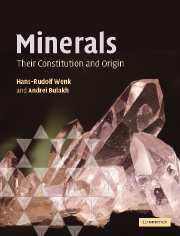Book contents
- Frontmatter
- Contents
- Preface
- Acknowledgments
- Figure credits
- Part I Structural features of minerals
- Part II Physical investigation of minerals
- Part III Variety of minerals and mineral-forming processes
- Part IV A systematic look at mineral groups
- Part V Applied mineralogy
- 30 Metalliferous mineral deposits
- 31 Gemstones
- 32 Cement minerals
- 33 Minerals and human health
- 34 Mineral composition of the solar system
- 35 Mineral composition of the earth
- Appendices
- Glossary
- References
- Index
- Plate section
- References
30 - Metalliferous mineral deposits
from Part V - Applied mineralogy
- Frontmatter
- Contents
- Preface
- Acknowledgments
- Figure credits
- Part I Structural features of minerals
- Part II Physical investigation of minerals
- Part III Variety of minerals and mineral-forming processes
- Part IV A systematic look at mineral groups
- Part V Applied mineralogy
- 30 Metalliferous mineral deposits
- 31 Gemstones
- 32 Cement minerals
- 33 Minerals and human health
- 34 Mineral composition of the solar system
- 35 Mineral composition of the earth
- Appendices
- Glossary
- References
- Index
- Plate section
- References
Summary
Introduction
Applied mineralogy deals with the practical applications of mineralogical knowledge, and the chapters in this section illustrate some of the main employment opportunities for mineralogists. Mineralogy is not merely an academic pursuit, but is of considerable economic significance. At one time mineralogy was applied largely to the field of mineral prospecting, but today the range of applications is much broader. Technological mineralogy and mineralogical materials science are growing fields, and developing needs constantly produce new branches of applied mineralogy, many of them making use of sophisticated instrumentation (Chapter 12). Mineralogical expertise is, of course, indispensable in geology and petrology. Other mineralogists work in gemology (see Chapter 31), in mineral extraction technology, in chemical plants, in the cement industry (see Chapter 32), and in ceramics and the manufacturing of refractory materials. Some mineralogists are also engaged in the fabrication of synthetic crystals, paints, enamels, and glazes, while others work in museums or become mineral dealers. Even in medicine there is a need for mineralogists. Environmental mineralogy, dealing with hazardous minerals, has recently become an important new application. An example is the study and remediation of asbestos contamination (see Chapter 33).
Prospecting mineralogy
Prospecting mineralogy deals with investigations that advance our knowledge of the occurrence of mineral deposits. Conventionally, the mineralogical features of ores have been the primary criteria for prospecting, and much has relied on the skills and accumulated wisdom of longtime miners.
- Type
- Chapter
- Information
- MineralsTheir Constitution and Origin, pp. 511 - 531Publisher: Cambridge University PressPrint publication year: 2004



